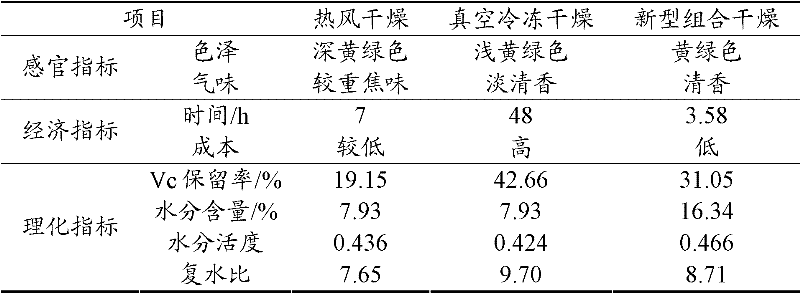Production method of evaporated vegetables
A production method and technology for dehydrated vegetables, applied in the direction of preservation of fruits/vegetables through dehydration, etc., can solve problems such as insufficient research on functional dehydrated vegetables, and achieve the effects of being beneficial to rehydration, reducing dehydration time, and overcoming poor quality.
- Summary
- Abstract
- Description
- Claims
- Application Information
AI Technical Summary
Problems solved by technology
Method used
Image
Examples
Embodiment 1
[0083] Example 1 : Production of dehydrated eggplant of the present invention
[0084] Choose 2500g of fresh long eggplants (with moisture content of about 80%), remove the heads and tails, wash them, and cut them into slices with a thickness of 20mm. After blanching with boiling water for 3 minutes, cool them quickly with tap water and spread them flat on a drying plate. Put it into the oven produced by Shanghai Boxun Industrial Co., Ltd. and dry it at 70℃ for 3.5 hours. According to the national standard GB 8858-88 "Method for the determination of dry matter and moisture content in fruit and vegetable products", the moisture content is determined by The total weight of the eggplant is 62%. Take it out of the oven and put it in a microwave oven produced by Guangzhou Microwave Heating and Drying Equipment Co., Ltd., at 3.0W.g -1 Dry for 15 minutes under the conditions of, and measure its moisture content to be 39% based on the total weight of the eggplant to obtain 800 grams of d...
Embodiment 2
[0086] Example 2 : Production of dehydrated carrots of the present invention
[0087] Carry out in the same way as in Example 1, but choose 1000g of fresh carrots, cut them into slices with a thickness of 20mm, blanch them in boiling water for 5 minutes, and dry them at a temperature of 70°C for 2.5 hours. The moisture content is measured as described The total weight of carrots is 61%. Then microwave drying, at 2.5W.g -1 Drying for 15 minutes under the conditions of, and measuring its moisture content as 36% based on the total weight of the carrot to obtain 250 grams of dried carrot. At room temperature, all the dried carrots were immersed in 90 mL of permeate containing 28% mannitol and 15% salt, stirred evenly, placed for 30 minutes, and then returned to the oven. The drying was continued for 1.2 hours at a temperature of 70°C to obtain 235 g of dehydrated carrots.
[0088] At a temperature of 25° C., using the method described in this specification, the dehydrated carrot of ...
Embodiment 3
[0089] Example 3 : Production of dehydrated loofah of the present invention
[0090] Carried out in the same way as in Example 1, but selected 2000g of fresh loofah, washed, cut into slices with a thickness of 20mm, blanched in boiling water for 2 minutes, placed in a hot air drying oven, and dried at 65°C 2h, the moisture content is determined to be 60% based on the total weight of the loofah. Then microwave drying, at 2.5W.g -1 Dry for 15 min under the conditions of, and measure the moisture content to be 38% based on the total weight of the loofah to obtain 490 grams of dried loofah. At room temperature, immerse all the dried loofah in 165mL penetrating solution containing 25% sorbitol and 15% salt, stir evenly, leave it for 15 minutes, and put it back in the oven. The drying was continued at a temperature of 65°C for 0.8 hours to obtain 430 g of dehydrated loofah.
[0091] At a temperature of 25° C., the method described in this specification is used to determine that the wa...
PUM
 Login to View More
Login to View More Abstract
Description
Claims
Application Information
 Login to View More
Login to View More - R&D
- Intellectual Property
- Life Sciences
- Materials
- Tech Scout
- Unparalleled Data Quality
- Higher Quality Content
- 60% Fewer Hallucinations
Browse by: Latest US Patents, China's latest patents, Technical Efficacy Thesaurus, Application Domain, Technology Topic, Popular Technical Reports.
© 2025 PatSnap. All rights reserved.Legal|Privacy policy|Modern Slavery Act Transparency Statement|Sitemap|About US| Contact US: help@patsnap.com

